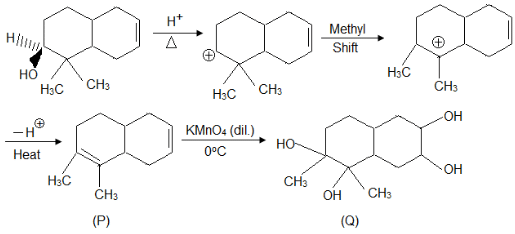Integer Answer Type Questions for JEE: Alcohols, Phenols & Ethers | Chapter-wise Tests for JEE Main & Advanced PDF Download
Q.1. The number of moles of Grignard’s reagent required to prepare one molecule of tertiary alcohol from one mole of acetyl chloride is.
Ans. 2
Q.2. In the reaction of optically active. 4 bromo 2 amino 4 methyl heptan 3-ol, with sodium hydroxide how many stereoisomers are possible.
Ans. 8
number of chiral carbon is 3 ⇒ optical isomer = 23 = 8.
Q.3. the rearrangement is possible in how many reactions among the above reaction.
the rearrangement is possible in how many reactions among the above reaction.
Ans. 1
(Only reaction with HBr form carbocation)
Q.4. How many moles of Grignard reagent can react with one mole of the given compound?
Ans. 7
(A) 1 mole each with - -OH, -C ≡ CH and -COCH3
(B) 2 mole each with COOEt and COCl Total = 7
Q.5. How many substituent will increase the acidity of alchol?
—NO2, –CH3, —O—CH3, —Br, —CHO
Ans. 3
–NO2, –Br, –CHO, elecgtron with drawing group.
Q.6. Calculate the minimum number of moles of R-Mg-X (Grignard reagent) required in the formation of a mole of cyclic Silicone.
Ans. 6
R - Mg - X + SiCl4 → Alkyl chloro silane
Q.7. The number of resonance structures for ‘N’ is ___.
Ans. 9
Naphthalen-2-ol acts as an acid and reacts with NaOH to form salt sodium naphthalen-2-olate which is compound N. The number of resonance structures for N is 9.
Q.8. Total number of isomers, considering both structural and stereoisomers, of cyclic ethers with the molecular formula C4H8O is ____.
Ans. 10
One of the four-membered cyclic structures exists as pair of enantiomers, contributing 2 to the total.
Two of the three-membered cyclic structures exist as pairs of enantiomers, contributing 4 to the total.
Also one of the three-membered structures exhibits geometrical isomerism adding 1 to the total structure.
Q.9. The number of the hydroxyl group(s) in Q is ___
Ans. 4
Q.10. Total number of hydroxyl groups present in a molecule of the major product P is.
Ans. 6
The total number of hydroxyl groups present in a molecule of the major product P is 6
|
446 docs|929 tests
|























